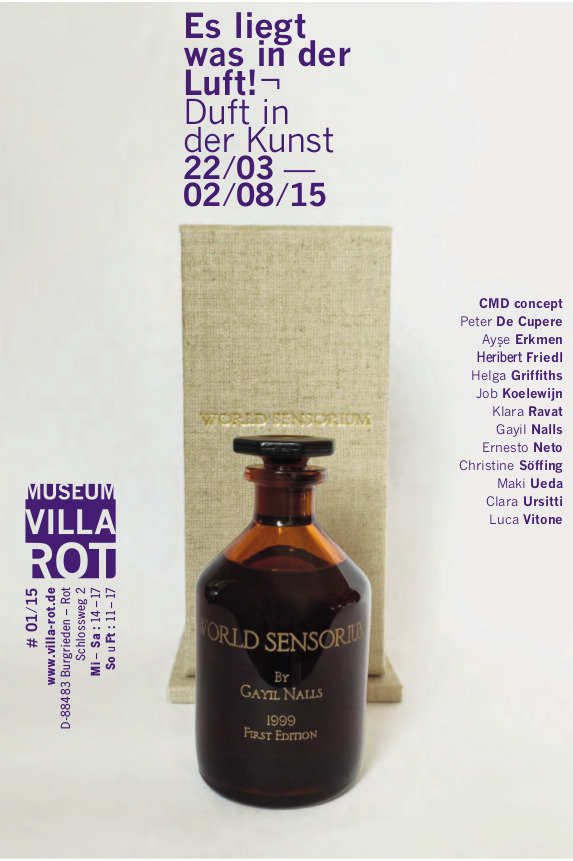There's Something in the Air!
dal 21/3/2015 al 1/8/2015
Segnalato da
Peter De Cupere
Ayse Erkmen
Helga Griffiths
Job Koelewijn
Gayil Nalls
Ernesto Neto
Klara Ravat
Christine Soffing
Maki Ueda
Clara Ursitti
Luca Vitone
CMD concept
Caro Verbeek
Stefanie Dathe
21/3/2015
There's Something in the Air!
Museum Villa Rot, Burgrieden-Rot
Scent in Contemporary Art. The exhibition traces the importance of the olfaction and its different roles in the artistic debate now and during the avantgarde. With installations by 12 international contemporary artists, and an historical excursion into Futuristic and Surrealistic approaches and theories.

curated by Caro Verbeek and Stefanie Dathe
The exhibition at the Museum Villa Rot
traces the importance of the olfaction
and its different roles in the artistic debate now and during the avantgarde. As
biochemical messages scents arouse
feelings, memories and subjective or
collectively conditioned associations.
Scents provoke, they can be attractive
or repulsive, can influence, deceive and
seduce emotions. They affect social and
sexual behavior, they are triggers for
sympathy and antipathy and can even
change the hormonal status.
Artists use olfactory stimulants often subversive and thus treat timeless and current questions of
our society. They pick the issues of fragrantes and seductive ambrosiacos from animals, plants
and perfumery as well as the associated desires of paradise and eroticism. They analyze the odor
pattern of landscapes and settlement areas. They deal with the ambivalent relation to our body
odor, decrypt the molecular structures of fragrances, reveal the discrepancy between experiences
of natural and synthetic origin, reflect aspects of air pollution and show that a more sensitive perception of the environment through the nose in the 21st century is more relevant than ever.
The exhibition at the Museum Villa Rot presents installations by international contemporary artists,
who examine the sense of smell and fragrances, their cause, composition, effect and memory potential under different aspects. It also provides an art historical excursion which delivers insight into
Futuristic and Surrealistic approaches and theories. Olfactory heritage is volatile, but an essential
part of our material culture, and (art historical) past.
Following artists are selected and invited to participate in the exhibition:
Peter De Cupere (B) / Ayse Erkmen (TUR) / Helga Griffiths (D) / Job Koelewijn (NL) / Gayil
Nalls (USA) / Ernesto Neto (BRA) / Klara Ravat (SP) / Christine Söffing (D) / Maki Ueda (JPN)
/ Clara Ursitti (CAN) / Luca Vitone (I) / CMD concept (NL)
Luca Vitone investigates the characteristics of places and locations, from a geographic, social, political and cultural point of view. He is interested in how places are characterized through art, carto-graphy, music, food, political groupings and ethnic minorities. The mental maps he then creates, are constructed from materials that could be considered relics or leftovers, such as dust or food. From the mid nineties onwards there was a shift from an objective general approach to the topic to a more personal and subjective one, involving specific places, and autobiographic memory.
The necessity of physical presence and the invisibility of smell intrigue Luca Vitone. He calls his olfactory pieces olfactory sculptures, for their threedimensional quality, and the atmosphere they create in a given space. The Italian nose was invited for a collaboration destined for the Neuer Berliner Kunstverein. This time the smell was much more abstract and conceptual, not reminiscent of anything we know. Imperium is the smell of power which is scentless, except for that typical odor lingering in offices or the specific smell of money. The smell Maria came up with was a perfume that is seductive at first sniff, but after being in the room for a little while, it becomes too intense and ‘one want to open a window, to get some fresh air’.
Since the room in which he diffuses the scents are empty, it is important to create a contrast between the clinical museological space, and the invisible, inherently intimate sculpture in it. Part of Imperium are also four seemingly empty monochrome paintings. They are covered in dust. Dust from German institutions that represent power: the executive (Bundesgerichtshof, Karlsruhe), the economic (Deutsche Bundes-bank), the legislative (Deutscher Bundestag) and the cultural one (Pergamonmuseum). The latter was especially chosen because the museum’s collections of the Middle East communicate an aspect of colonialism. The Germans, like Johann Winckelman, brought their intellectual heritage to other places in the world and influenced academic thinking.
The olfacoto-visual narrative created by Luca Vitone is an implicit and poetic reference to power, but also to the practice of exhibiting art: “Artists in the 20th century started their trajectory by rebelling against the museum, while ending their career by trying to be part of it.” This certainly counts for his Italian predeces- sors, the Futurists. But while their aromatic heritage has disappeared, their paintings are conserved in museums worldwide. Has Luca Vitone thought of a way to conserve his volatile heritage.
The exhibition is and will be accompanied by a catalogue (Hardcover / german/english / 128 pages / 18 €) and the parfum 2115 (Limited
edition / 50 ml / 40 €) developed by the artist and synesthetien Christine Söffing and perfumer
Kim Weisswange.
Image: Gayil Nalls / World Sensorium, First Record / 2000 / World Social Olfactory Sculpture of Aromatic Phytogenic Material, Amber Borosilicate Bottle, 10x5cm, 100ml at 25%, Auflage 18 / Courtesy of the artist
Press contact:
Marcel Hess +49(0)7392-8335 hess@villa-rot.de
Opening 22/3/15, 11 a.m.
Museum Villa Rot
Schlossweg 2 D-88483 Burgrieden-Rot
Opening Hours:
Wed - Sat 2 pm – 5 pm
Sun 11 am – 5 pm
Admission:
Adults 6,00 €
Students, Seniors, Groups (10 - 25 Persons) 4,00 € p.P.
Pupils 1,50 €
Families 10,00 €



